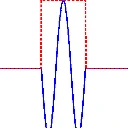
The Spectrum of an exponentially decaying Light Pulse
In this problem you will learn how to apply the Fourier Transformation to a simple exponentially decaying electric field.
When dealing with Maxwell's equations, we often need to switch between \((\mathbf{r},t)\)- and \((\mathbf{k},\omega)\)-space, i.e. between space-time and Fourier domain. This is advantageous, since derivatives in space and time are simple products in Fourier domain.
The Fourier transformation, or often short Fourier transform, of the electric field is given by:
\begin{eqnarray*}\mathbf{E}\left(\mathbf{r},t\right)&=&\intop_{-\infty}^{\infty}\mathbf{\overline{E}}\left(\mathbf{r},\omega\right)e^{-i\omega t}d\omega\\\mathbf{\overline{E}}\left(\mathbf{r},\omega\right)&=&\frac{1}{2\pi}\intop_{-\infty}^{\infty}\mathbf{E}\left(\mathbf{r},t\right)e^{i\omega t}dt \end{eqnarray*} and \begin{eqnarray*} \mathbf{E}\left(\mathbf{r},t\right)&=&\intop_{-\infty}^{\infty}\mathbf{E}\left(\mathbf{k},t\right)e^{i\mathbf{kr}}d\mathbf{r}\\\mathbf{E}\left(\mathbf{k},t\right)&=&\frac{1}{2\pi}\intop_{-\infty}^{\infty}\mathbf{E}\left(\mathbf{r},t\right)e^{-i\mathbf{kr}}d\mathbf{k}\end{eqnarray*}
To show that the FT is linear we need to prove \(F[a\cdot f(t)+b\cdot g(t)]=a\cdot F[f(t)]+b\cdot F[g(t)]\). Therefore we will use a simple example:
\begin{eqnarray*} FT\left[aE_{1}(t)+bE_{2}(t)\right]&=&\intop_{-\infty}^{\infty}\left[aE_{1}(t)+bE_{2}(t)\right]e^{i\omega t}dt\\&=&a\intop_{-\infty}^{\infty}E_{1}(t)e^{i\omega t}dt+b\intop_{-\infty}^{\infty}E_{2}(t)e^{i\omega t}dt\\&=&aFT\left[E_{1}(t)\right]+bFT\left[E_{2}(t)\right] \end{eqnarray*}
Here we consider an electric field with an offset in time. The Fourier transformation leads to:
\begin{eqnarray*} FT\left[E(t-t_{0})\right](\omega)&=&\frac{1}{2\pi}\int_{-\infty}^{\infty}dt\ E(t-t_{0})e^{i\omega t}\\&=&\frac{1}{2\pi}e^{i\omega t_{0}}\int_{-\infty}^{\infty}dt\ E(t-t_{0})e^{i\omega(t-t_{0})} \end{eqnarray*}
Now substitute \(t^{\prime}=t-t_{0}\), which leads to:
\begin{eqnarray*}FT\left[E(t-t_{0})\right](\omega)&=&\frac{1}{2\pi}e^{i\omega t_{0}}\int_{-\infty}^{\infty}dt^{\prime}\ E(t^{\prime})e^{i\omega t^{\prime}}\\&=&\frac{1}{2\pi}e^{i\omega t_{0}}\widetilde{E}(\omega) \end{eqnarray*}
How you can easy check:
\[FT\left[e^{i\omega_{0}t}E(t)\right](\omega)=\widetilde{E}(\omega-\omega_{0})\]
Going into Fourier space, we just have to replace derivatives via:
\[\frac{\partial}{\partial t}\longleftrightarrow-i\omega~\mathrm{and}~\frac{\partial}{\partial\mathbf{r}}\longleftrightarrow i\mathbf{k}.\]
In order to show that \(\frac{\partial}{\partial t}\longrightarrow-i\omega\), we will start with the inverse Fourier transform for \(\left[\mathbf{\frac{\partial}{\partial t}E}\left(\mathbf{r},t\right)\right]\), obtaining:
\begin{eqnarray*} \frac{1}{2\pi}\intop_{-\infty}^{\infty}\left[\mathbf{\frac{\partial}{\partial t}E}\left(\mathbf{r},t\right)\right]e^{-i\omega t}dt&_{P.I.}^{=}&\frac{1}{2\pi}\mathbf{E}\left(\mathbf{r},t\right)e^{-i\omega t}|_{-\infty}^{\infty}-\frac{i\omega}{2\pi}\intop_{-\infty}^{\infty}\mathbf{E}\left(\mathbf{r},t\right)e^{-i\omega t}dt\\&=&-\frac{i\omega}{2\pi}\intop_{-\infty}^{\infty}\mathbf{E}\left(\mathbf{r},t\right)e^{-i\omega t}dt=-i\omega\mathbf{\overline{E}}\left(\mathbf{r},\omega\right) \end{eqnarray*}
To obtain a general rule for the \(n^{\textrm{th}}\)-derivative, we perform the second derivative:
\begin{eqnarray*} \frac{1}{2\pi}\intop_{-\infty}^{\infty}\left[\mathbf{\frac{\partial^{2}}{\partial t^{2}}E}\left(\mathbf{r},t\right)\right]e^{-i\omega t}dt&=&\frac{1}{2\pi}\left[\mathbf{\frac{\partial}{\partial t}E}\left(\mathbf{r},t\right)\right]e^{-i\omega t}|_{-\infty}^{\infty}-\frac{i\omega}{2\pi}\intop_{-\infty}^{\infty}\left[\mathbf{\frac{\partial}{\partial t}E}\left(\mathbf{r},t\right)\right]e^{-i\omega t}dt\\&=&-\frac{i\omega}{2\pi}\mathbf{E}\left(\mathbf{r},t\right)e^{-i\omega t}|_{-\infty}^{\infty}+\frac{\omega^{2}}{2\pi}\intop_{-\infty}^{\infty}\mathbf{E}\left(\mathbf{r},t\right)e^{-i\omega t}dt=\omega^{2}\mathbf{\overline{E}}\left(\mathbf{r},\omega\right) \end{eqnarray*}
Hence, we get for the \(n^{\textrm{th}}\)-derivative:
\[\frac{1}{2\pi}\intop_{-\infty}^{\infty}\left[\mathbf{\frac{\partial^{n}}{\partial t^{n}}E}\left(\mathbf{r},t\right)\right]e^{-i\omega t}dt=\frac{\left(-i\omega\right)^{n}}{2\pi}\intop_{-\infty}^{\infty}\mathbf{E}\left(\mathbf{r},t\right)e^{-i\omega t}dt=\left(-i\omega\right)^{n}\mathbf{\overline{E}}\left(\mathbf{r},\omega\right)\]
with \(n\in\mathbb{N}\)
To show that \(\frac{\partial}{\partial\mathbf{r}}\longrightarrow i\mathbf{k}\) we will use the same strategy as above. Starting with the Fourier transform for \(\left[\frac{\partial}{\partial\mathbf{r}}\mathbf{E}\left(\mathbf{r},t\right)\right]\) we obtain:
\[\begin{eqnarray*} \frac{1}{2\pi}\intop_{-\infty}^{\infty}\left[\frac{\partial}{\partial\mathbf{r}}\mathbf{E}\left(\mathbf{r},t\right)\right]e^{-i\mathbf{kr}}d\mathbf{k}&_{P.I.}^{=}&\frac{1}{2\pi}\mathbf{E}\left(\mathbf{r},t\right)e^{-i\mathbf{kr}}|_{-\infty}^{\infty}+\frac{i\mathbf{k}}{2\pi}\intop_{-\infty}^{\infty}\mathbf{E}\left(\mathbf{r},t\right)e^{-i\mathbf{kr}}d\mathbf{k}\\&=&\frac{i\mathbf{k}}{2\pi}\intop_{-\infty}^{\infty}\mathbf{E}\left(\mathbf{r},t\right)e^{-i\mathbf{kr}}d\mathbf{k}=i\mathbf{k}\mathbf{E}\left(\mathbf{k},t\right) \end{eqnarray*}\]
Again, the second order derivative:
\begin{eqnarray*} \frac{1}{2\pi}\intop_{-\infty}^{\infty}\left[\frac{\partial^{2}}{\partial\mathbf{r}^{2}}\mathbf{E}\left(\mathbf{r},t\right)\right]e^{-i\mathbf{kr}}d\mathbf{k}&_{P.I.}^{=}&\frac{1}{2\pi}\left[\frac{\partial}{\partial\mathbf{r}}\mathbf{E}\left(\mathbf{r},t\right)\right]e^{-i\mathbf{kr}}|_{-\infty}^{\infty}+\frac{i\mathbf{k}}{2\pi}\intop_{-\infty}^{\infty}\left[\frac{\partial}{\partial\mathbf{r}}\mathbf{E}\left(\mathbf{r},t\right)\right]e^{-i\mathbf{kr}}d\mathbf{k}\\&=&\frac{i\mathbf{k}}{2\pi}\mathbf{E}\left(\mathbf{r},t\right)e^{-i\mathbf{kr}}|_{-\infty}^{\infty}-\frac{\mathbf{k^{2}}}{2\pi}\intop_{-\infty}^{\infty}\mathbf{E}\left(\mathbf{r},t\right)e^{-i\mathbf{kr}}d\mathbf{k}=\mathbf{-k^{2}}\mathbf{E}\left(\mathbf{k},t\right) \end{eqnarray*}
We find analogously the general form:
\[\frac{1}{2\pi}\intop_{-\infty}^{\infty}\left[\frac{\partial^{n}}{\partial\mathbf{r}^{n}}\mathbf{E}\left(\mathbf{r},t\right)\right]e^{-i\mathbf{kr}}d\mathbf{k}=\frac{\left(i\mathbf{k}\right)^{n}}{2\pi}\intop_{-\infty}^{\infty}\mathbf{E}\left(\mathbf{r},t\right)e^{-i\mathbf{kr}}d\mathbf{k}=\left(i\mathbf{k}\right)^{n}\mathbf{E}\left(\mathbf{k},t\right)\]
Hence, we can write in general:
\[\frac{\partial^{n}}{\partial t^{n}}\longleftrightarrow(-i\omega)^{n}~\mathrm{and}~\frac{\partial^{n}}{\partial\mathbf{r}^{n}}\longleftrightarrow(i\mathbf{k})^{n}.\]
Any linear partial differential equation transforms to an algebraic equation or set of equations in Fourier space, which can be solved conveniently. The general solution is time and space can be found by superposition and inverse Fourier transform.
Here consider the integral:
\[\left(\widetilde{E}(\omega)=\frac{1}{2\pi}\int_{-\infty}^{\infty}E(t)e^{i\omega t}dt\right)^{\star}\]
Take the complex conjugate inside the brackets, obtaining:
\[\widetilde{E}^{\star}(\omega)=\frac{1}{2\pi}\int_{-\infty}^{\infty}E(t)e^{i(-\omega)t}dt=\widetilde{E}(-\omega)\]
\begin{eqnarray*}\int\limits _{-\infty}^{\infty}|f(t)|^{2}dt&=&\int\limits _{-\infty}^{\infty}|f(\omega)|^{2}d\omega\\&=&\int\limits _{-\infty}^{\infty}\left[\int\limits _{-\infty}^{\infty}f(t)e^{i\omega t}dt\int\limits _{-\infty}^{\infty}f^{*}(t')e^{-i\omega t'}dt'\right]d\omega\\&=&\int\limits _{-\infty}^{\infty}\left[\int\limits _{-\infty}^{\infty}\int\limits _{-\infty}^{\infty}f(t)f^{*}(t')e^{i\omega\left(t-t'\right)}dtdt'\right]d\omega\\&=&\int\limits _{-\infty}^{\infty}\int\limits _{-\infty}^{\infty}f(t)f^{*}(t')\delta\left(t-t'\right)dtdt'\\&=&\int\limits _{-\infty}^{\infty}f(t)f^{*}(t)dt \end{eqnarray*}.
Therefore:
\[ \int \limits_{-\infty}^{\infty}|f(t)|^{2}dt=\int\limits _{-\infty}^{\infty}|f(\omega)|^{2}d\omega \]

In this problem you will learn how to apply the Fourier Transformation to a simple exponentially decaying electric field.

We compute the spectrum of a rectangular shaped pulse with underlying oscillating electric field.

The Heaviside step function is very important in physics. It often models a sudden switch-on phenomenon and is therefore present in a lot of integrals.